BULAW 1502 Assignment: Contract Law and Property Law Analysis
VerifiedAdded on 2023/03/21
|7
|1633
|61
Homework Assignment
AI Summary
This Business Law assignment solution addresses two key legal issues. Question 1 analyzes a contract law scenario involving a vehicle sale, focusing on the formation of an option contract, breach of contract, and potential claims and defenses. The analysis covers offer, acceptance, consideration, and the enforceability of the agreement, referencing relevant case law. Question 2 delves into property law concepts, defining and explaining chattel mortgages, perfection of security interests, fixtures, the Torrens system, and leaseholds. The assignment provides a comprehensive overview of the legal principles involved in both contract and property law, providing a detailed understanding of the legal issues and their resolution. The solution is a student contribution to Desklib, a platform providing AI based study tools for students.
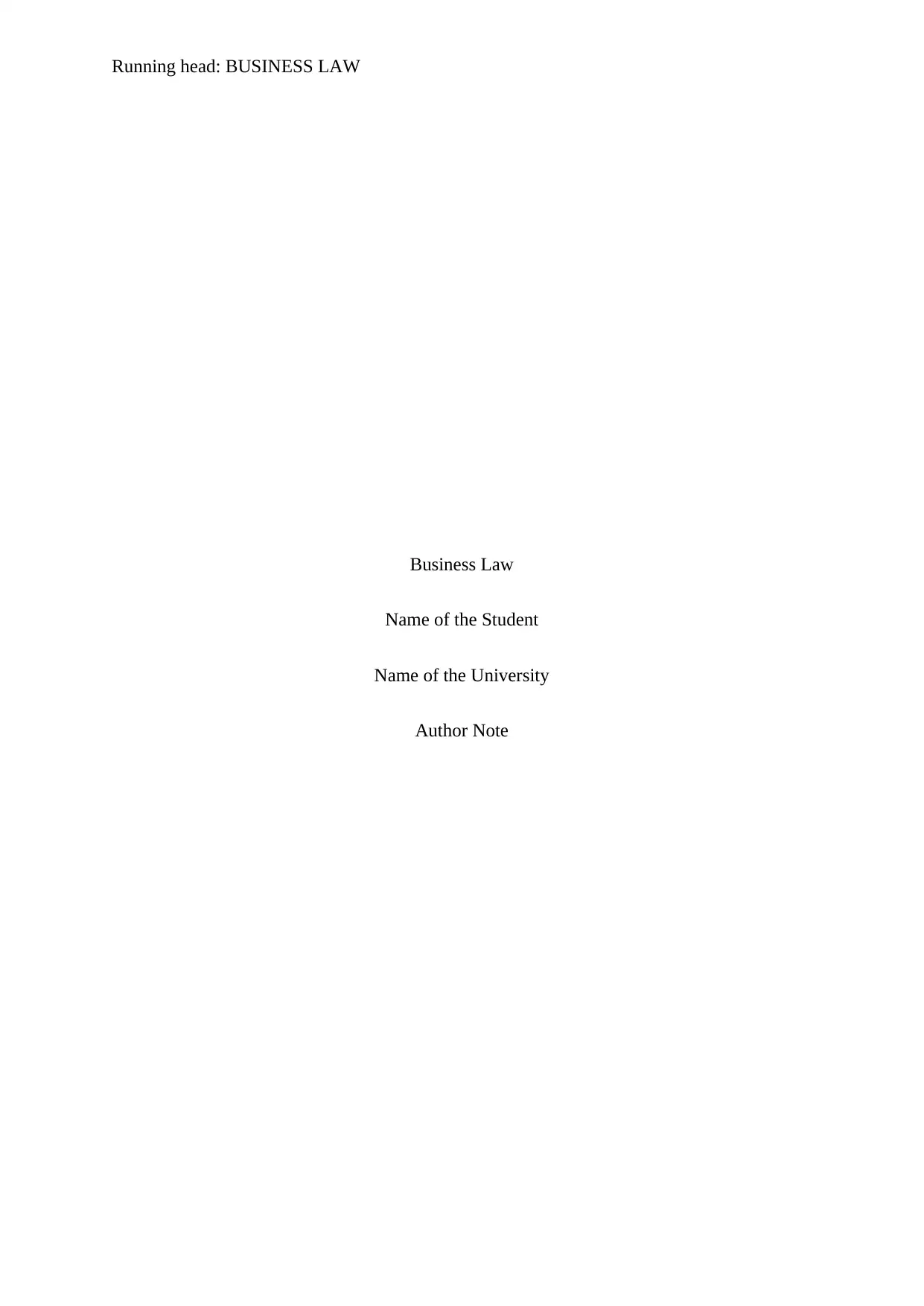
Running head: BUSINESS LAW
Business Law
Name of the Student
Name of the University
Author Note
Business Law
Name of the Student
Name of the University
Author Note
Paraphrase This Document
Need a fresh take? Get an instant paraphrase of this document with our AI Paraphraser
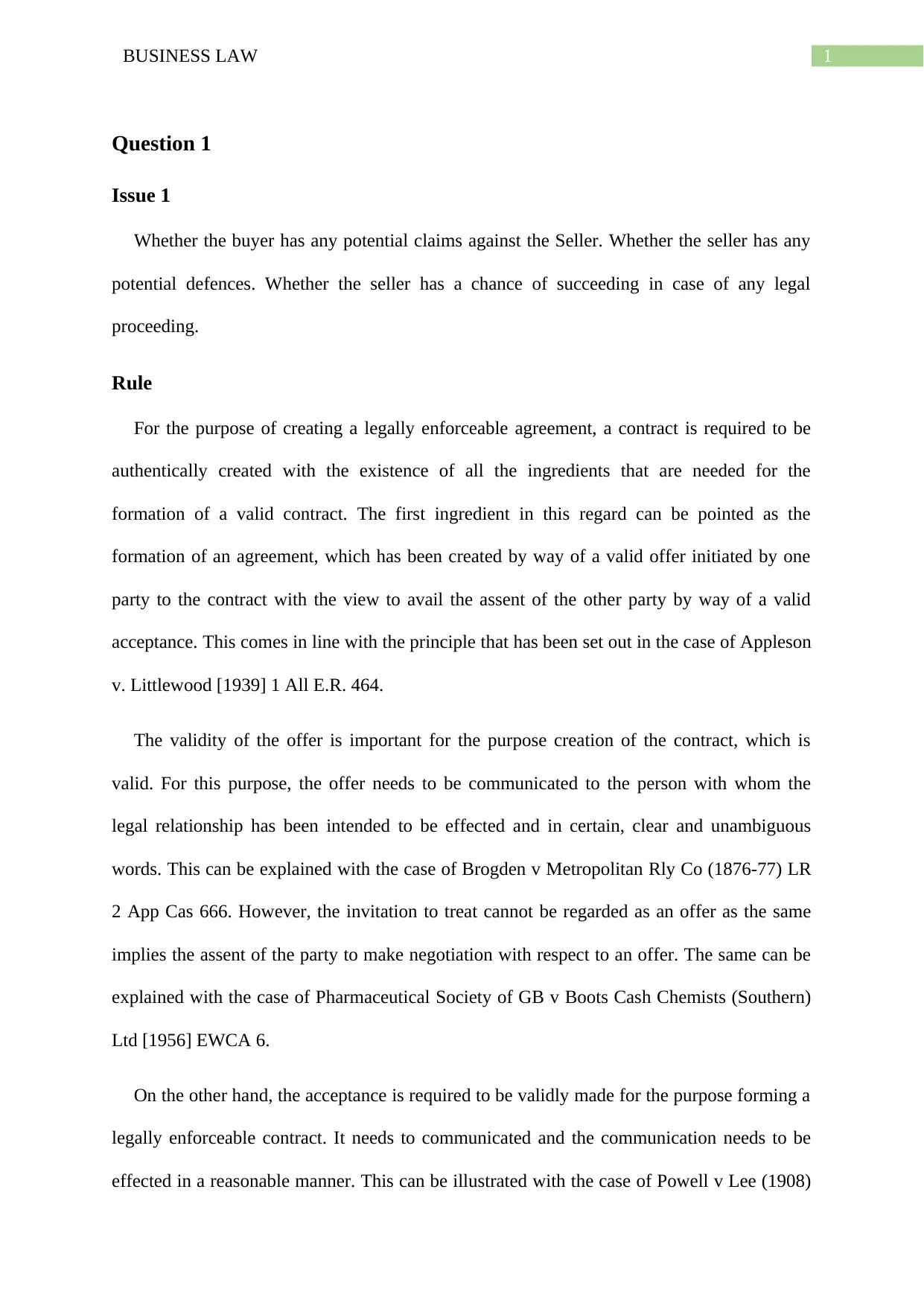
1BUSINESS LAW
Question 1
Issue 1
Whether the buyer has any potential claims against the Seller. Whether the seller has any
potential defences. Whether the seller has a chance of succeeding in case of any legal
proceeding.
Rule
For the purpose of creating a legally enforceable agreement, a contract is required to be
authentically created with the existence of all the ingredients that are needed for the
formation of a valid contract. The first ingredient in this regard can be pointed as the
formation of an agreement, which has been created by way of a valid offer initiated by one
party to the contract with the view to avail the assent of the other party by way of a valid
acceptance. This comes in line with the principle that has been set out in the case of Appleson
v. Littlewood [1939] 1 All E.R. 464.
The validity of the offer is important for the purpose creation of the contract, which is
valid. For this purpose, the offer needs to be communicated to the person with whom the
legal relationship has been intended to be effected and in certain, clear and unambiguous
words. This can be explained with the case of Brogden v Metropolitan Rly Co (1876-77) LR
2 App Cas 666. However, the invitation to treat cannot be regarded as an offer as the same
implies the assent of the party to make negotiation with respect to an offer. The same can be
explained with the case of Pharmaceutical Society of GB v Boots Cash Chemists (Southern)
Ltd [1956] EWCA 6.
On the other hand, the acceptance is required to be validly made for the purpose forming a
legally enforceable contract. It needs to communicated and the communication needs to be
effected in a reasonable manner. This can be illustrated with the case of Powell v Lee (1908)
Question 1
Issue 1
Whether the buyer has any potential claims against the Seller. Whether the seller has any
potential defences. Whether the seller has a chance of succeeding in case of any legal
proceeding.
Rule
For the purpose of creating a legally enforceable agreement, a contract is required to be
authentically created with the existence of all the ingredients that are needed for the
formation of a valid contract. The first ingredient in this regard can be pointed as the
formation of an agreement, which has been created by way of a valid offer initiated by one
party to the contract with the view to avail the assent of the other party by way of a valid
acceptance. This comes in line with the principle that has been set out in the case of Appleson
v. Littlewood [1939] 1 All E.R. 464.
The validity of the offer is important for the purpose creation of the contract, which is
valid. For this purpose, the offer needs to be communicated to the person with whom the
legal relationship has been intended to be effected and in certain, clear and unambiguous
words. This can be explained with the case of Brogden v Metropolitan Rly Co (1876-77) LR
2 App Cas 666. However, the invitation to treat cannot be regarded as an offer as the same
implies the assent of the party to make negotiation with respect to an offer. The same can be
explained with the case of Pharmaceutical Society of GB v Boots Cash Chemists (Southern)
Ltd [1956] EWCA 6.
On the other hand, the acceptance is required to be validly made for the purpose forming a
legally enforceable contract. It needs to communicated and the communication needs to be
effected in a reasonable manner. This can be illustrated with the case of Powell v Lee (1908)
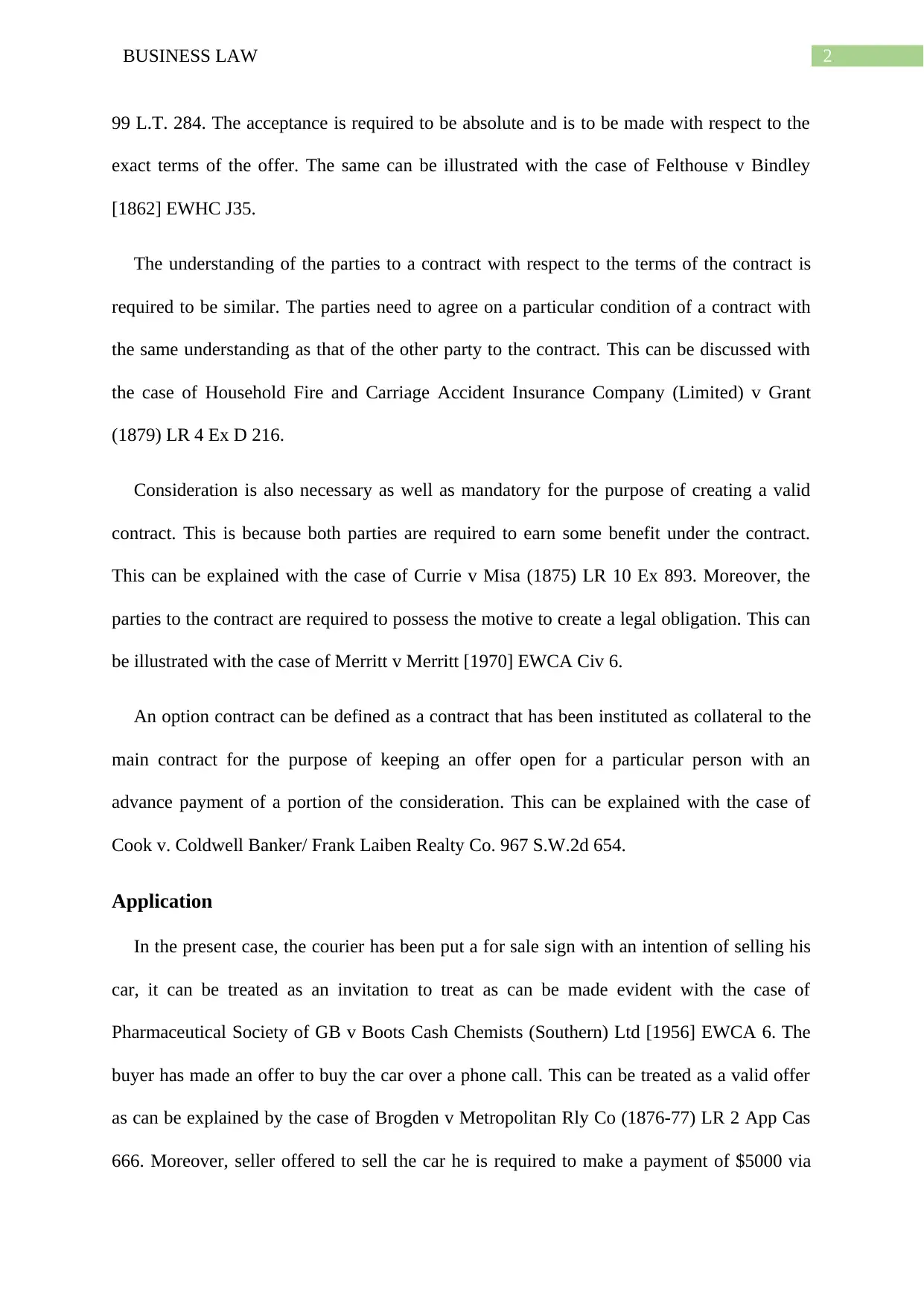
2BUSINESS LAW
99 L.T. 284. The acceptance is required to be absolute and is to be made with respect to the
exact terms of the offer. The same can be illustrated with the case of Felthouse v Bindley
[1862] EWHC J35.
The understanding of the parties to a contract with respect to the terms of the contract is
required to be similar. The parties need to agree on a particular condition of a contract with
the same understanding as that of the other party to the contract. This can be discussed with
the case of Household Fire and Carriage Accident Insurance Company (Limited) v Grant
(1879) LR 4 Ex D 216.
Consideration is also necessary as well as mandatory for the purpose of creating a valid
contract. This is because both parties are required to earn some benefit under the contract.
This can be explained with the case of Currie v Misa (1875) LR 10 Ex 893. Moreover, the
parties to the contract are required to possess the motive to create a legal obligation. This can
be illustrated with the case of Merritt v Merritt [1970] EWCA Civ 6.
An option contract can be defined as a contract that has been instituted as collateral to the
main contract for the purpose of keeping an offer open for a particular person with an
advance payment of a portion of the consideration. This can be explained with the case of
Cook v. Coldwell Banker/ Frank Laiben Realty Co. 967 S.W.2d 654.
Application
In the present case, the courier has been put a for sale sign with an intention of selling his
car, it can be treated as an invitation to treat as can be made evident with the case of
Pharmaceutical Society of GB v Boots Cash Chemists (Southern) Ltd [1956] EWCA 6. The
buyer has made an offer to buy the car over a phone call. This can be treated as a valid offer
as can be explained by the case of Brogden v Metropolitan Rly Co (1876-77) LR 2 App Cas
666. Moreover, seller offered to sell the car he is required to make a payment of $5000 via
99 L.T. 284. The acceptance is required to be absolute and is to be made with respect to the
exact terms of the offer. The same can be illustrated with the case of Felthouse v Bindley
[1862] EWHC J35.
The understanding of the parties to a contract with respect to the terms of the contract is
required to be similar. The parties need to agree on a particular condition of a contract with
the same understanding as that of the other party to the contract. This can be discussed with
the case of Household Fire and Carriage Accident Insurance Company (Limited) v Grant
(1879) LR 4 Ex D 216.
Consideration is also necessary as well as mandatory for the purpose of creating a valid
contract. This is because both parties are required to earn some benefit under the contract.
This can be explained with the case of Currie v Misa (1875) LR 10 Ex 893. Moreover, the
parties to the contract are required to possess the motive to create a legal obligation. This can
be illustrated with the case of Merritt v Merritt [1970] EWCA Civ 6.
An option contract can be defined as a contract that has been instituted as collateral to the
main contract for the purpose of keeping an offer open for a particular person with an
advance payment of a portion of the consideration. This can be explained with the case of
Cook v. Coldwell Banker/ Frank Laiben Realty Co. 967 S.W.2d 654.
Application
In the present case, the courier has been put a for sale sign with an intention of selling his
car, it can be treated as an invitation to treat as can be made evident with the case of
Pharmaceutical Society of GB v Boots Cash Chemists (Southern) Ltd [1956] EWCA 6. The
buyer has made an offer to buy the car over a phone call. This can be treated as a valid offer
as can be explained by the case of Brogden v Metropolitan Rly Co (1876-77) LR 2 App Cas
666. Moreover, seller offered to sell the car he is required to make a payment of $5000 via
⊘ This is a preview!⊘
Do you want full access?
Subscribe today to unlock all pages.

Trusted by 1+ million students worldwide
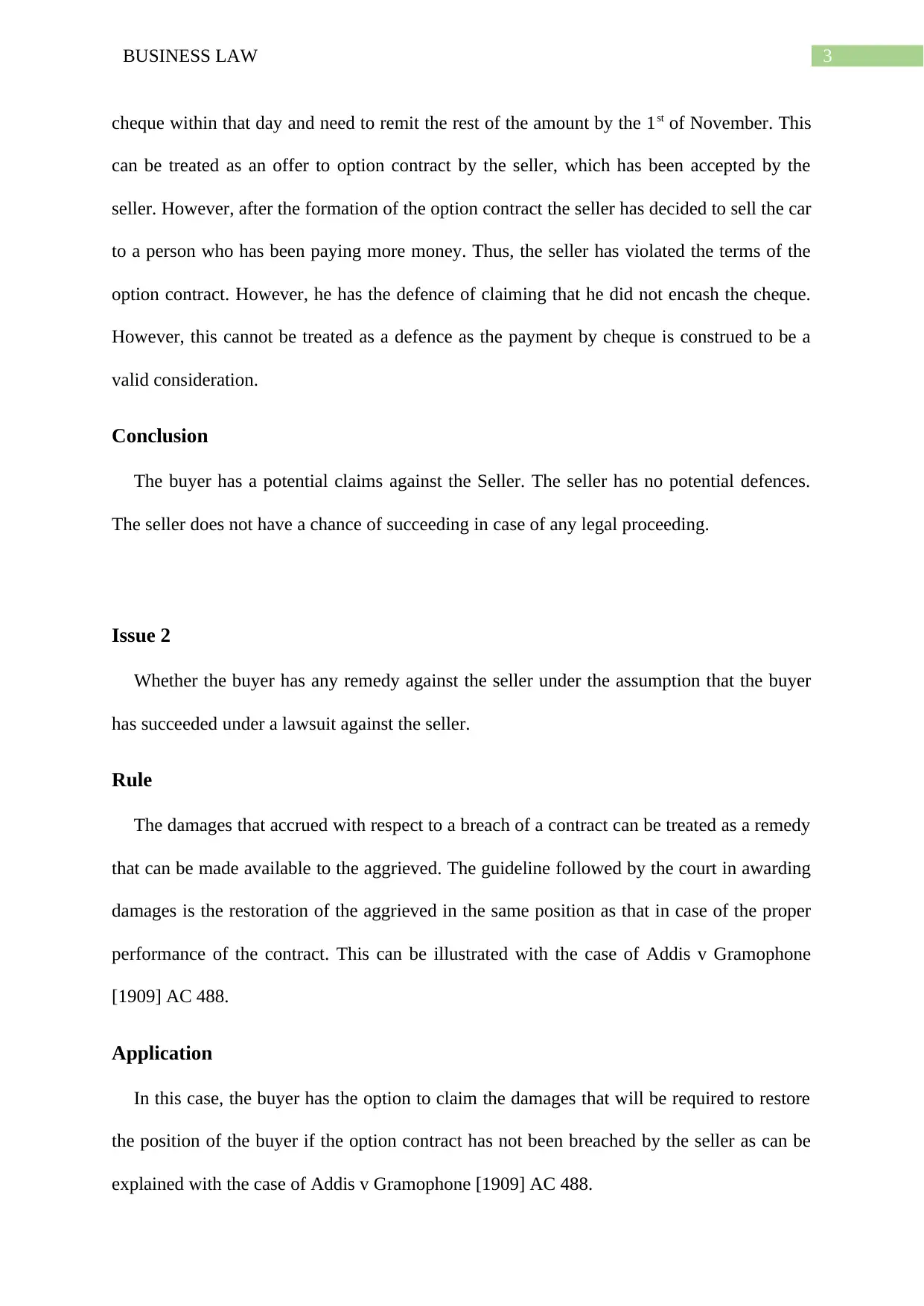
3BUSINESS LAW
cheque within that day and need to remit the rest of the amount by the 1st of November. This
can be treated as an offer to option contract by the seller, which has been accepted by the
seller. However, after the formation of the option contract the seller has decided to sell the car
to a person who has been paying more money. Thus, the seller has violated the terms of the
option contract. However, he has the defence of claiming that he did not encash the cheque.
However, this cannot be treated as a defence as the payment by cheque is construed to be a
valid consideration.
Conclusion
The buyer has a potential claims against the Seller. The seller has no potential defences.
The seller does not have a chance of succeeding in case of any legal proceeding.
Issue 2
Whether the buyer has any remedy against the seller under the assumption that the buyer
has succeeded under a lawsuit against the seller.
Rule
The damages that accrued with respect to a breach of a contract can be treated as a remedy
that can be made available to the aggrieved. The guideline followed by the court in awarding
damages is the restoration of the aggrieved in the same position as that in case of the proper
performance of the contract. This can be illustrated with the case of Addis v Gramophone
[1909] AC 488.
Application
In this case, the buyer has the option to claim the damages that will be required to restore
the position of the buyer if the option contract has not been breached by the seller as can be
explained with the case of Addis v Gramophone [1909] AC 488.
cheque within that day and need to remit the rest of the amount by the 1st of November. This
can be treated as an offer to option contract by the seller, which has been accepted by the
seller. However, after the formation of the option contract the seller has decided to sell the car
to a person who has been paying more money. Thus, the seller has violated the terms of the
option contract. However, he has the defence of claiming that he did not encash the cheque.
However, this cannot be treated as a defence as the payment by cheque is construed to be a
valid consideration.
Conclusion
The buyer has a potential claims against the Seller. The seller has no potential defences.
The seller does not have a chance of succeeding in case of any legal proceeding.
Issue 2
Whether the buyer has any remedy against the seller under the assumption that the buyer
has succeeded under a lawsuit against the seller.
Rule
The damages that accrued with respect to a breach of a contract can be treated as a remedy
that can be made available to the aggrieved. The guideline followed by the court in awarding
damages is the restoration of the aggrieved in the same position as that in case of the proper
performance of the contract. This can be illustrated with the case of Addis v Gramophone
[1909] AC 488.
Application
In this case, the buyer has the option to claim the damages that will be required to restore
the position of the buyer if the option contract has not been breached by the seller as can be
explained with the case of Addis v Gramophone [1909] AC 488.
Paraphrase This Document
Need a fresh take? Get an instant paraphrase of this document with our AI Paraphraser
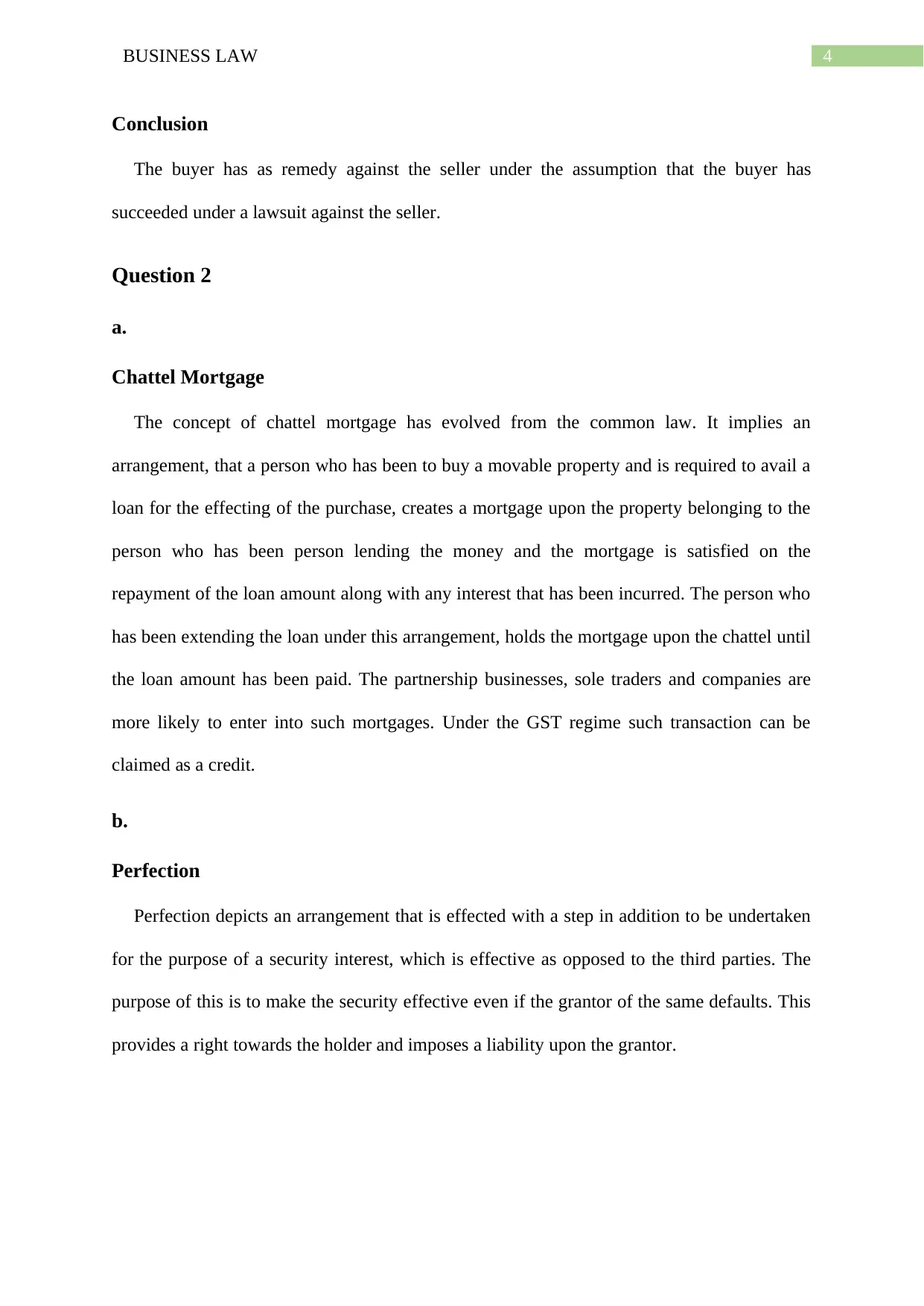
4BUSINESS LAW
Conclusion
The buyer has as remedy against the seller under the assumption that the buyer has
succeeded under a lawsuit against the seller.
Question 2
a.
Chattel Mortgage
The concept of chattel mortgage has evolved from the common law. It implies an
arrangement, that a person who has been to buy a movable property and is required to avail a
loan for the effecting of the purchase, creates a mortgage upon the property belonging to the
person who has been person lending the money and the mortgage is satisfied on the
repayment of the loan amount along with any interest that has been incurred. The person who
has been extending the loan under this arrangement, holds the mortgage upon the chattel until
the loan amount has been paid. The partnership businesses, sole traders and companies are
more likely to enter into such mortgages. Under the GST regime such transaction can be
claimed as a credit.
b.
Perfection
Perfection depicts an arrangement that is effected with a step in addition to be undertaken
for the purpose of a security interest, which is effective as opposed to the third parties. The
purpose of this is to make the security effective even if the grantor of the same defaults. This
provides a right towards the holder and imposes a liability upon the grantor.
Conclusion
The buyer has as remedy against the seller under the assumption that the buyer has
succeeded under a lawsuit against the seller.
Question 2
a.
Chattel Mortgage
The concept of chattel mortgage has evolved from the common law. It implies an
arrangement, that a person who has been to buy a movable property and is required to avail a
loan for the effecting of the purchase, creates a mortgage upon the property belonging to the
person who has been person lending the money and the mortgage is satisfied on the
repayment of the loan amount along with any interest that has been incurred. The person who
has been extending the loan under this arrangement, holds the mortgage upon the chattel until
the loan amount has been paid. The partnership businesses, sole traders and companies are
more likely to enter into such mortgages. Under the GST regime such transaction can be
claimed as a credit.
b.
Perfection
Perfection depicts an arrangement that is effected with a step in addition to be undertaken
for the purpose of a security interest, which is effective as opposed to the third parties. The
purpose of this is to make the security effective even if the grantor of the same defaults. This
provides a right towards the holder and imposes a liability upon the grantor.
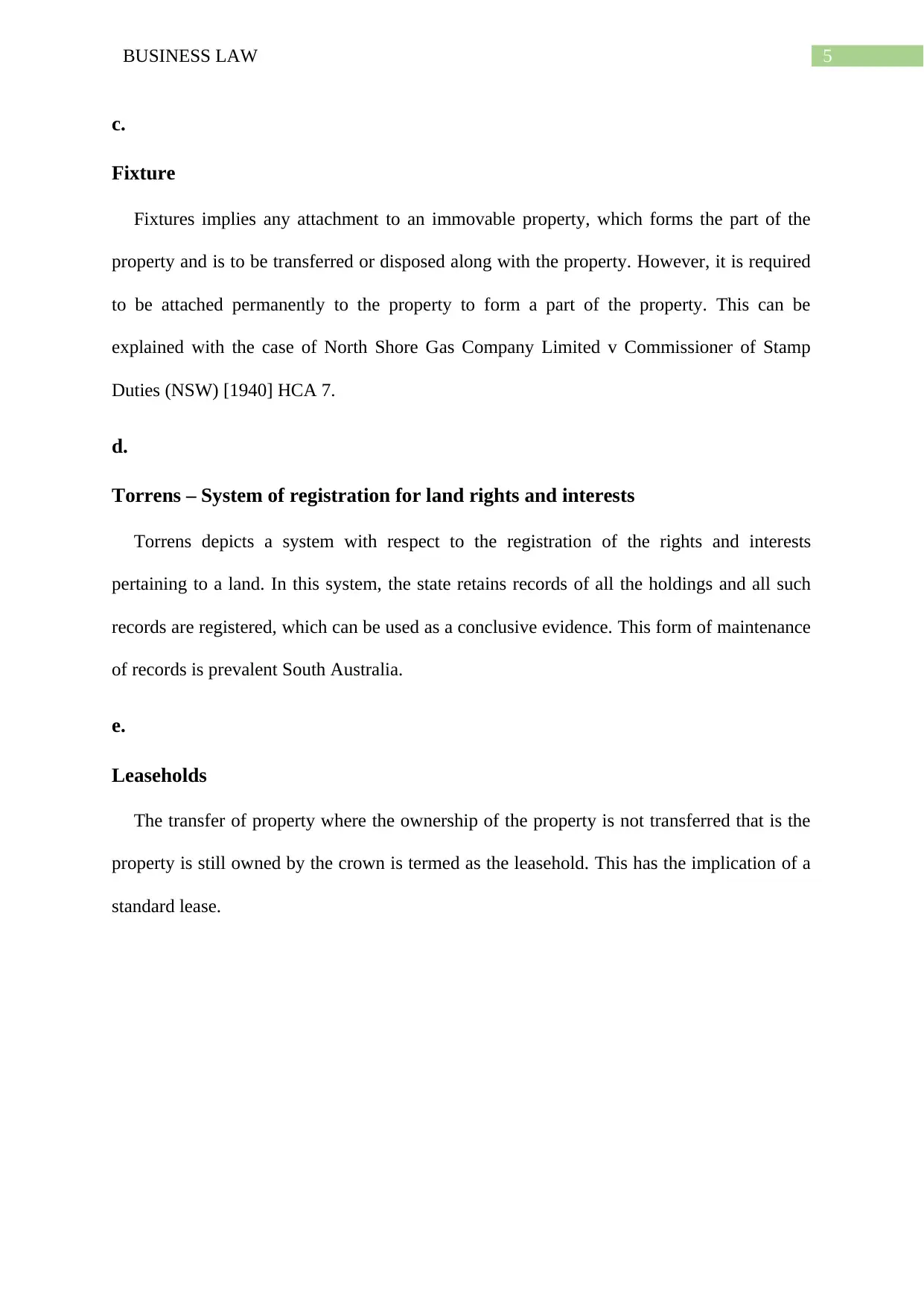
5BUSINESS LAW
c.
Fixture
Fixtures implies any attachment to an immovable property, which forms the part of the
property and is to be transferred or disposed along with the property. However, it is required
to be attached permanently to the property to form a part of the property. This can be
explained with the case of North Shore Gas Company Limited v Commissioner of Stamp
Duties (NSW) [1940] HCA 7.
d.
Torrens – System of registration for land rights and interests
Torrens depicts a system with respect to the registration of the rights and interests
pertaining to a land. In this system, the state retains records of all the holdings and all such
records are registered, which can be used as a conclusive evidence. This form of maintenance
of records is prevalent South Australia.
e.
Leaseholds
The transfer of property where the ownership of the property is not transferred that is the
property is still owned by the crown is termed as the leasehold. This has the implication of a
standard lease.
c.
Fixture
Fixtures implies any attachment to an immovable property, which forms the part of the
property and is to be transferred or disposed along with the property. However, it is required
to be attached permanently to the property to form a part of the property. This can be
explained with the case of North Shore Gas Company Limited v Commissioner of Stamp
Duties (NSW) [1940] HCA 7.
d.
Torrens – System of registration for land rights and interests
Torrens depicts a system with respect to the registration of the rights and interests
pertaining to a land. In this system, the state retains records of all the holdings and all such
records are registered, which can be used as a conclusive evidence. This form of maintenance
of records is prevalent South Australia.
e.
Leaseholds
The transfer of property where the ownership of the property is not transferred that is the
property is still owned by the crown is termed as the leasehold. This has the implication of a
standard lease.
⊘ This is a preview!⊘
Do you want full access?
Subscribe today to unlock all pages.

Trusted by 1+ million students worldwide
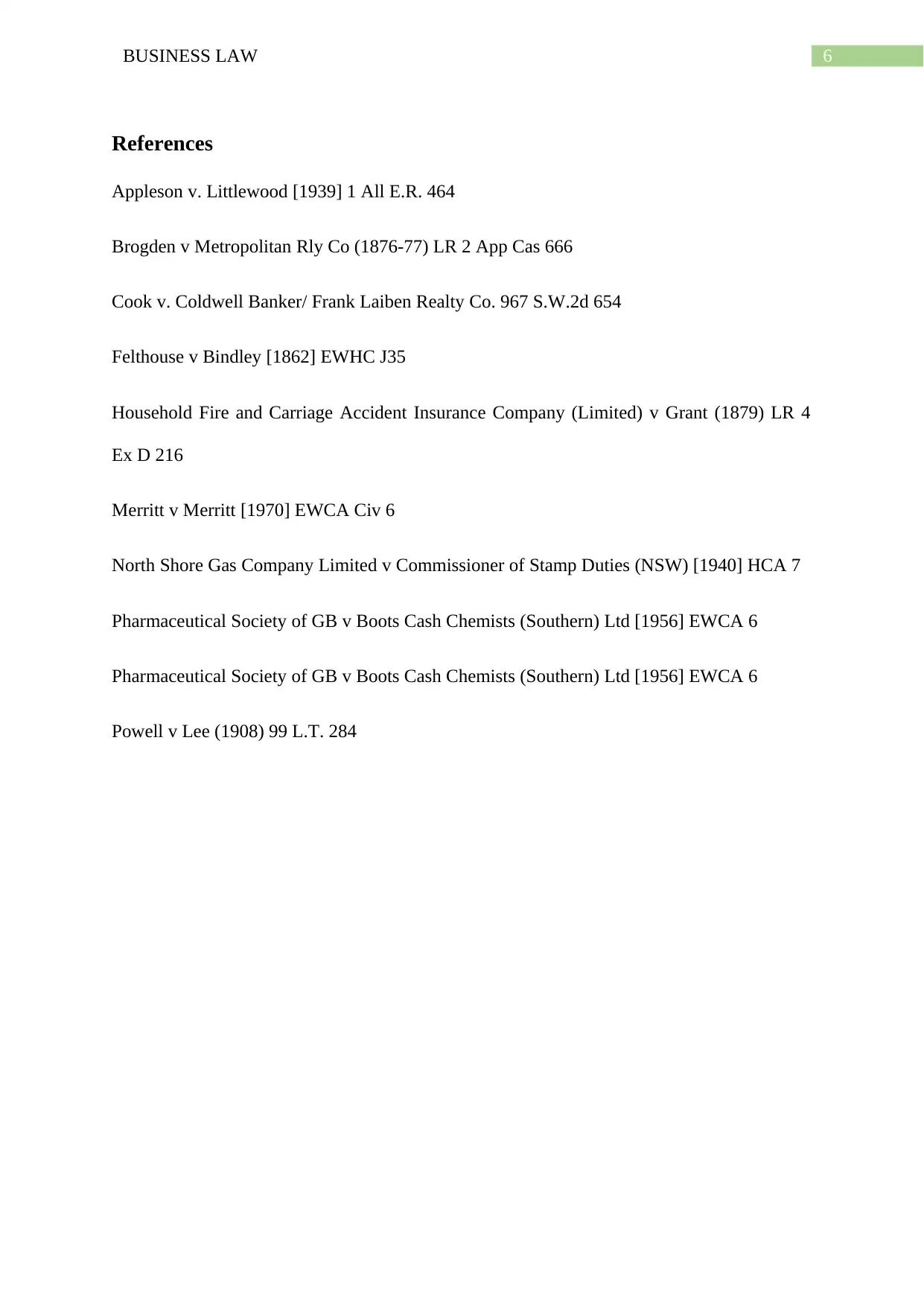
6BUSINESS LAW
References
Appleson v. Littlewood [1939] 1 All E.R. 464
Brogden v Metropolitan Rly Co (1876-77) LR 2 App Cas 666
Cook v. Coldwell Banker/ Frank Laiben Realty Co. 967 S.W.2d 654
Felthouse v Bindley [1862] EWHC J35
Household Fire and Carriage Accident Insurance Company (Limited) v Grant (1879) LR 4
Ex D 216
Merritt v Merritt [1970] EWCA Civ 6
North Shore Gas Company Limited v Commissioner of Stamp Duties (NSW) [1940] HCA 7
Pharmaceutical Society of GB v Boots Cash Chemists (Southern) Ltd [1956] EWCA 6
Pharmaceutical Society of GB v Boots Cash Chemists (Southern) Ltd [1956] EWCA 6
Powell v Lee (1908) 99 L.T. 284
References
Appleson v. Littlewood [1939] 1 All E.R. 464
Brogden v Metropolitan Rly Co (1876-77) LR 2 App Cas 666
Cook v. Coldwell Banker/ Frank Laiben Realty Co. 967 S.W.2d 654
Felthouse v Bindley [1862] EWHC J35
Household Fire and Carriage Accident Insurance Company (Limited) v Grant (1879) LR 4
Ex D 216
Merritt v Merritt [1970] EWCA Civ 6
North Shore Gas Company Limited v Commissioner of Stamp Duties (NSW) [1940] HCA 7
Pharmaceutical Society of GB v Boots Cash Chemists (Southern) Ltd [1956] EWCA 6
Pharmaceutical Society of GB v Boots Cash Chemists (Southern) Ltd [1956] EWCA 6
Powell v Lee (1908) 99 L.T. 284
1 out of 7
Related Documents
Your All-in-One AI-Powered Toolkit for Academic Success.
+13062052269
info@desklib.com
Available 24*7 on WhatsApp / Email
![[object Object]](/_next/static/media/star-bottom.7253800d.svg)
Unlock your academic potential
Copyright © 2020–2025 A2Z Services. All Rights Reserved. Developed and managed by ZUCOL.





